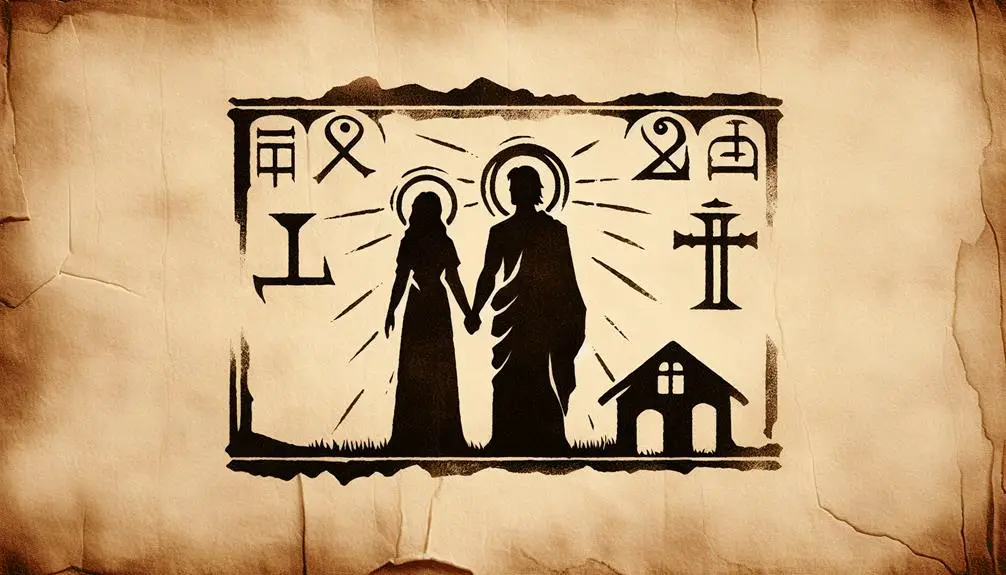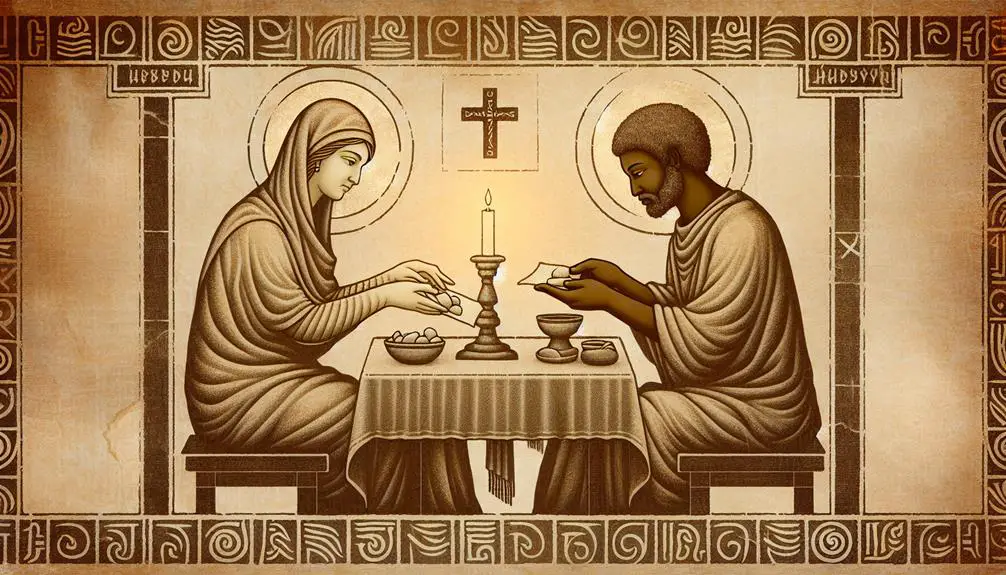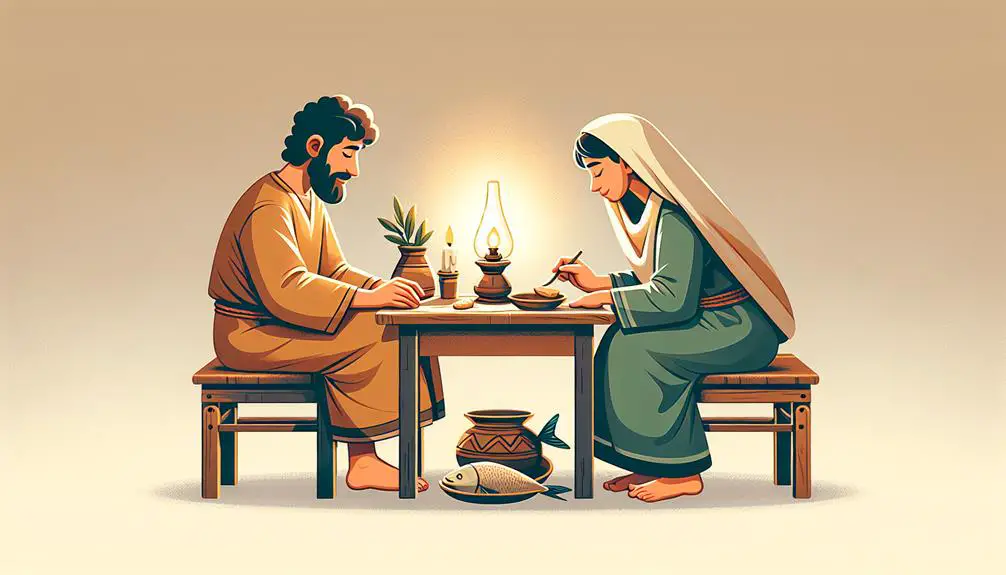New insights reveal Peter's marital status in the Bible, uncovering the societal and early church perspectives on apostleship and marriage.

Did Peter Have a Wife in the Bible
While some might argue the Bible remains silent on Peter's marital status, you'll find that Scripture does hint at his domestic life. For instance, the Gospels mention Jesus healing Peter's mother-in-law, which naturally suggests Peter had a wife.
This detail not only enriches our understanding of Peter's personal life but also provides a backdrop for exploring societal norms and early church perspectives on marriage and apostleship. As you consider the implications for believers and the broader historical context, you'll uncover layers of meaning that could shift how you view the apostle's life and contributions to the early Christian community.
Key Takeaways
- Biblical evidence suggests Peter had a wife, inferred from the healing of his mother-in-law.
- Scholarly interpretations support Peter's marriage, aligning with societal norms of Jewish and Roman cultures.
- Despite debates, there's no definitive answer on Peter's marital status due to limited textual evidence.
- Peter's potential marriage reflects the compatibility of spiritual leadership with familial responsibilities.
Biblical Evidence

While examining the biblical evidence, it's clear that Peter indeed had a wife, as indicated by scriptural references to his mother-in-law. Canonical references within the New Testament, specifically in the Gospels of Matthew, Mark, and Luke, provide compelling evidence of this familial relationship. For instance, the Synoptic Gospels narrate an episode where Jesus heals Peter's mother-in-law, implicitly confirming Peter's marital status. This account isn't only a testament to Peter's personal life but also serves as a crucial piece of evidence within apostolic traditions, highlighting the human aspects of the apostles' lives.
Further analysis of these canonical references reveals an intricate layer of early Christian life and societal norms. Apostolic traditions, as preserved through these scriptural accounts, underscore the integration of familial and communal responsibilities within the early Church's framework. Thus, the acknowledgment of Peter's wife goes beyond mere anecdotal evidence, contributing to a deeper understanding of the apostolic era's social and religious fabric. It's this synthesis of scriptural evidence and apostolic traditions that offers a comprehensive insight into Peter's life, affirming his marital status through scholarly, objective analysis.
Historical Context

To grasp Peter's marital status fully, one must consider the historical context in which these biblical narratives unfolded. The period in question was deeply influenced by both Roman rule and Jewish traditions, each playing a pivotal role in shaping societal norms and personal lives.
On one hand, Roman influence permeated various aspects of daily life, including marriage customs, legal structures, and social hierarchies. This influence wasn't monolithic; it varied greatly depending on one's social status and locale within the vast Roman Empire. However, the Romans generally held marriage in high regard, emphasizing its importance for societal stability and lineage.
On the other hand, Jewish traditions provided a distinct framework for understanding and living out marital relationships. Within Jewish society, marriage wasn't just a personal or familial matter but a covenant deeply rooted in religious and cultural identity. The expectations for marriage, including roles and responsibilities, were largely informed by these traditions.
Considering these two profound influences, understanding Peter's marital status requires a nuanced appreciation of how Roman policies and Jewish customs intersected during this era. This complex backdrop is essential for anyone looking to understand the personal lives of biblical figures, including the possibility of Peter's marriage.
Scholarly Interpretations

Given the complex interplay of Roman and Jewish influences on marriage, scholars have extensively debated Peter's marital status, examining biblical texts and historical evidence for insights. This scrutiny has led to a spectrum of interpretative variations, reflecting the diverse scholarly perspectives on apostolic celibacy and the implications for Peter's life.
- Textual Analysis: Some scholars point to texts suggesting Peter had a wife, citing references to his mother-in-law in the Gospels. This direct mention contrasts with the idea of apostolic celibacy, which others argue was a later development in Christian tradition.
- Historical Context: Researchers consider the societal norms and expectations of marriage within both Jewish and Roman cultures of the time. This context is crucial for understanding the likelihood and significance of Peter being married.
- Theological Implications: The debate also encompasses theological interpretations, with some arguing that Peter's potential marriage would align with Jewish customs, while others emphasize the symbolic value of celibacy among the apostles, influencing early Christian practices.
In dissecting these scholarly interpretations, it's clear that the question of Peter's marital status can't be answered definitively. Instead, the discussion illuminates the broader complexities of interpreting ancient texts and understanding early Christian traditions.
Peter's Household

Regarding Peter's household, evidence from biblical narratives provides glimpses into its composition, suggesting the presence of familial ties, including a wife, through references to his mother-in-law. This detail, seemingly minor, carries significant weight in understanding the domestic dynamics within Peter's home. It indicates not only that Peter was married but also that he was part of a larger household structure that likely included extended family members. The mention of his mother-in-law being healed by Jesus further illuminates the intimate interactions Jesus had with Peter's family, showcasing the personal ties that bound them.
The dynamics within Peter's household would have been complex, given the era's social and economic conditions. Domestic responsibilities would have been shared among family members, with each playing a specific role to ensure the household's functioning. This structure suggests a level of normalcy and domesticity in Peter's life before his apostolic calling, which is often overshadowed by his later spiritual endeavors. Analyzing these household dynamics offers a more nuanced view of Peter, not just as a foundational figure in Christianity but as a man navigating familial and domestic responsibilities, highlighting the intersection between personal and spiritual spheres within his life.
Early Church Perspectives

Shifting our focus to the perspectives within the early church, it's essential to examine how Peter's marital status was understood and its implications for church leaders. Early Christian communities looked to the apostles for guidance in both spiritual and practical matters. The question of whether church leaders like Peter were married or practiced celibacy wasn't just a matter of curiosity but had significant theological and practical implications.
- Apostolic Celibacy: The early church grappled with the concept of celibacy among its leaders. Peter's marital status became a point of reference in these discussions, influencing views on the ideal state for church leadership.
- Leadership Dynamics: Understanding Peter's household situation sheds light on the dynamics of early Christian leadership. It questions the balance between personal life and spiritual obligations.
- Community Expectations: The early Christians' perception of Peter's marital status reflects broader expectations of leaders' personal lives, highlighting the tension between public ministry and private commitments.
In analyzing early church perspectives, it's clear that Peter's personal life was more than a trivial detail; it was a lens through which broader issues of apostolic celibacy and leadership dynamics were explored. This analysis underscores the complexity of early Christian leadership and the evolving standards within the church community.
Societal Norms

You'll find that societal norms significantly shaped marriage expectations in Peter's time, affecting both men and women's roles within the community.
These norms also influenced the impact on women's roles, underscoring a complex interplay between cultural practices and gender expectations.
Lastly, examining cultural marriage practices of the era reveals the underlying values and societal structures that guided these traditions.
Marriage Expectations Then
In the historical context of the era, societal norms dictated that marriage wasn't only expected but considered a foundational pillar of community and religious life. This expectation was interwoven with various facets of life, including:
- Divorce rates were significantly lower, as marriage was seen as a lifelong commitment.
- Love dynamics often played a secondary role to familial obligations and societal expectations.
- Marriage served as a means of securing social status and economic stability.
Analyzing these factors reveals a complex interplay between personal desires and societal pressures. Marriage wasn't just about personal fulfillment; it was a critical component of the social fabric, influencing everything from individual identity to community cohesion. Understanding this context helps illuminate the societal backdrop against which biblical figures, like Peter, lived their lives.
Impact on Women's Roles
The societal norms of the era significantly dictated women's roles, relegating them primarily to domestic duties and child-rearing, with marriage being a pivotal aspect of their identity and societal contribution. This framework substantially influenced gender dynamics, often limiting women's access to leadership opportunities within both religious and societal contexts.
Aspect |
Women's Roles |
Impact on Leadership Opportunities |
|---|---|---|
Domestic Duties |
Primary Focus |
Limited Engagement Outside Home |
Child-Rearing |
Central Responsibility |
Restricted Time for Other Roles |
Societal Identity |
Defined by Marital Status |
Reduced Individual Identity |
Contribution |
Through Family Care |
Narrow Scope for Leadership |
Gender Dynamics |
Subordinate Position |
Fewer Opportunities in Leadership |
This table illustrates the direct correlation between societal norms and the constrained roles and opportunities available to women, highlighting the need for a broader understanding of their potential beyond traditional confines.
Cultural Marriage Practices
Exploring cultural marriage practices reveals how deeply societal norms have shaped and defined the institution of marriage throughout history. These norms not only guide but also dictate how individuals enter and sustain marital relationships.
Consider the following aspects:
- Dowry systems, often seen as a means to solidify alliances or ensure financial stability, have varied significantly across cultures and eras.
- Marriage ceremonies, rich in tradition and symbolism, reflect the values and beliefs of a society, serving as a public declaration of the marital bond.
- Societal expectations regarding marriage age, choice of spouse, and roles within marriage underscore the influence of cultural norms on personal decisions.
Analyzing these elements provides insight into the complex interplay between marriage practices and societal norms, highlighting how deeply ingrained these traditions are in shaping human relationships.
Implications for Believers

You may wonder how Peter's marital status shapes your understanding of spiritual leadership within your faith community.
It suggests that personal life choices, such as marriage, don't detract from one's ability to lead spiritually.
Instead, it emphasizes the relevance of applying biblical examples to contemporary discussions about the roles within the church.
Marital Status Relevance
Understanding Peter's marital status provides valuable insights into biblical perspectives on marriage and its significance for believers' lives. The fact that a prominent apostle like Peter was married carries modern significance for your personal faith journey in several ways:
- It highlights the compatibility of marital life with spiritual leadership, distinguishing between personal callings and universal mandates.
- It underscores the value of partnership and mutual support in fulfilling one's spiritual and earthly duties.
- It reflects the diversity of life situations among early Christians, reminding you that faith can thrive in various personal circumstances.
Analyzing Peter's marital status thus encourages a nuanced understanding of how personal relationships and faith intersect, offering a model for integrating personal commitments with spiritual pursuits.
Spiritual Leadership Model
Peter's marriage serves as a profound example of how spiritual leadership and personal life can coexist harmoniously, offering believers a model for balancing their faith commitments with family responsibilities. This balance underscores essential leadership traits such as empathy, patience, and the ability to engage in effective conflict resolution.
As you delve deeper into Peter's life, you'll notice that his leadership wasn't solely defined by his public ministry but also by how he managed his household. The integration of strong spiritual values within the family unit provided a robust framework for addressing challenges and fostering an environment of mutual support and understanding.
This dual focus on spiritual guidance and familial harmony offers a comprehensive model for believers seeking to embody leadership qualities in all aspects of their lives.
Frequently Asked Questions
How Did Peter's Marital Status Influence His Relationship With Other Apostles and Early Christian Leaders?
Peter's marital status subtly shaped his interactions with other apostles and early Christian leaders, reflecting on apostolic traditions and community dynamics.
You'd notice that being married might've allowed him to offer a unique perspective on leadership and community life, integrating family values into the burgeoning Christian ethos.
This aspect of his life contributed to a richer, more inclusive understanding of leadership within the early church, influencing its development and practices.
Were There Any Specific Teachings or Parables Delivered by Jesus That Directly Referenced or Were Influenced by Peter's Marital Status?
You're exploring how Jesus' teachings or parables might reflect or be influenced by specific disciples' life situations, such as marital status. While Jesus' miracle healings and fishing stories don't explicitly reference any disciple's marital life, they symbolize deeper spiritual truths applicable to all, regardless of personal circumstances.
Analyzing these narratives, there's no direct evidence that Peter's marital status specifically shaped Jesus' teachings. The focus remains on broader spiritual and moral lessons.
How Has the Perception of Peter's Marital Status Evolved Within Different Christian Denominations Over the Centuries?
You'll find that denominational differences have significantly shaped the evolution of perceptions regarding Peter's marital status over centuries. Historical documentation and interpretations have varied widely, leading to diverse views among Christian denominations.
Some have emphasized celibacy and spiritual leadership without marital ties, while others have acknowledged Peter's marriage as part of his human experience. This variance reflects broader theological and doctrinal debates within Christianity about clergy marriage and apostolic precedent.
What Are Some Modern Theological Debates or Controversies Surrounding the Interpretation of Peter's Marital Life?
You're diving into modern theological debates that often center around the celibacy debate and questions of historical accuracy.
Scholars and theologians argue over how celibacy has been valued and interpreted in light of Peter's marital life. This discussion impacts broader church policies and beliefs about clergy marriage.
You'll find that interpretations vary widely, influenced by evolving understandings of historical texts and the role of tradition in shaping modern Christian thought.
How Is Peter's Marital Status Portrayed in Religious Art and Literature Outside of the Canonical Bible Texts?
In artistic depictions and literature analysis, you'll find Peter's marital status varies widely. Artists and authors outside the canonical Bible texts have interpreted his life through their cultural and personal lenses, often reflecting the norms and values of their times.
This has resulted in a rich tapestry of portrayals, from the devoted husband to the celibate apostle. These interpretations offer a fascinating insight into how religious figures are viewed and reimagined across history.
Conclusion
In conclusion, you've explored the layers of evidence suggesting Peter indeed had a wife. From biblical texts to scholarly interpretations, the consensus leans towards affirming his marital status.
But why does this matter? Understanding Peter's household offers a richer insight into his humanity and the early church's societal fabric. It challenges us to reflect on the complexities of leadership within Christian communities, grounding our spiritual heroes in the realities of everyday life.



Sign up